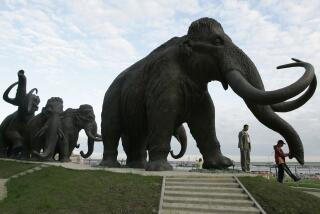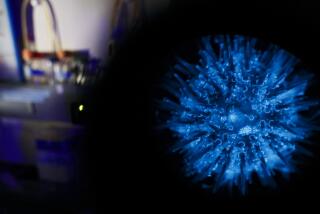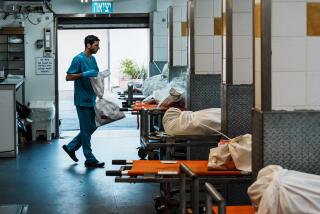New Lab Takes Aim at Illegal Animal Trade
ASHLAND, Ore. — FBI agents have long relied on a world-class crime laboratory to help them enforce the nation’s laws by gathering and identifying tissue samples, spent bullets and other scientific crime-scene evidence.
U.S. Fish and Wildlife Service investigators, on the other hand, had to beg favors from the overworked Smithsonian Institution, understaffed state labs or sympathetic universities when they needed a scientific assist.
As a result, Fish and Wildlife officials concede, a great many poachers and black marketeers went unpunished, as evidenced by alarming, unnatural declines in the numbers of many endangered species.
That is about to change. The Fish and Wildlife Service has opened a state-of-the-art wildlife forensics laboratory in Ashland--believed to be the first of its kind--and is recruiting 30 pathologists, technicians and support staff to combat the global market for illegal game.
Problems in Past
“In the past, a lot of this lab work simply never got done,” said Kenneth W. Goddard, a published novelist and former biochemist at the Huntington Beach Police Department crime lab who now directs the National Fish and Wildlife Forensics Laboratory. “We’d take some of it to universities or museums, but sometimes we simply had to bluff our way through investigations. We’d go, ‘Gee, this looks like 60,000 pounds of sea turtle meat,’ and hope the bad guys would admit it.”
No more. The new lab is assembling a section on veterinary serology, or serum chemistry, that will take a technology recently developed to identify human tissue and modify it to identify the species and sex of animal blood and tissue.
Another section will identify the morphology, or structure, of animals--to tell, for example, whether eagle talons peddled as talismans were taken illegally from a federally protected bald eagle or some other species.
In addition to more traditional criminal-investigation services, including gathering and analyzing weapons, fingerprints, footprints and tire tracks, the lab also is able to analyze evidence using electron microscopy, liquid and gas chromatography and infrared spectraphotometry.
Tools of Discovery
Such tools could, for example, discover suntan oil made from endangered sea turtles, or identify the composition and brand name of the poison used to kill any one of dozens of endangered predators.
Together, the pathologists and their tools will do what other, conventional crime labs do: Find, examine and interpret physical evidence to match suspect, victim and crime scene.
A wildlife illustrator and full-time photographer supplement the laboratory by producing drawings, charts, pictures and videotapes for use as evidence in court, to train the agency’s 250 wildlife agents, or to educate the public.
Eventually, basic research being done at the $4.5-million facility will let pathologists distinguish African ivory from Asian ivory, and determine whether Asian aphrodisiac capsules really contain the powdered horns of endangered black rhinoceroses or common dairy cows.
“It’s very difficult to look at a handbag, for example, and tell if it was made from alligator or crocodile (hide),” Goddard explained. “Alligators are biologically secure and can (legally) be sold commercially, but crocodiles are critically endangered.”
Brink of Extinction
Indeed, Fish and Wildlife officials said hundreds of species are in danger of being hunted into extinction to satisfy commercial demands for their hides, horns, teeth, talons, feathers and other body parts. Other species have been decimated by their members being captured live for sale.
Elephant herds are slaughtered with automatic rifles for their ivory tusks, for example, while leopards are skinned for fur coats, and parrots are rounded up for sale as pets. Even some plants, such as the saguaro cactus, are rustled for the black market.
The Fish and Wildlife Service said the United States is the world’s largest trader of both live wildlife and wildlife products, accounting for one-fifth of the estimated $5-billion annual world market.
Because the illegal wildlife market is global, the lab is available to help foreign governments save their own endangered species, as well as to help enforce U.S. laws against killing protected species, hunting out of season and importing banned animal products.
Goddard said lab services are free of charge not only to such federal bureaus as the Fish and Wildlife Service and National Marine Fisheries Service, but also to state game officials and the more than 100 member nations of the Convention on International Trade in Endangered Species.
Kind of ‘Scotland Yard’
The lab already has produced a videotape to advertise itself at the October meeting of that United Nations agency in Switzerland, Goddard said.
Some are already calling the month-old lab a “Scotland Yard for endangered species.” That is not too far afield, because some of the lab’s analytical devices were indeed developed by that legendary London police agency for use in conventional criminology.
Offering aid to other countries is practical as well as altruistic, Goddard said. By giving such help, the lab--the only one of its kind anywhere, he said--should become the world leader in wildlife forensics. At the same time, it can quickly and cheaply develop a data base of tissue, blood and anatomical information from around the world.
Until that data store grows significantly, Goddard said the lab will not be able to identify most of the samples it accepts for analysis without borrowing from other collections, including the Smithsonian.
Laboratory sleuthing that is difficult enough in regular crime laboratories is complicated immeasurably by the large number of plants and animals that the lab will deal with, said serologist Wayne Ferguson, formerly of the New Mexico State Police laboratory.
‘Whole Noah’s Ark’
“In a typical police lab, you’re dealing with one species, Homo sapiens, “ said Thomas J. Rayl, evidence and property section chief. “But Wayne and the others have to contend with the whole Noah’s Ark.”
Adding to the difficulty is the condition of the evidence used to prosecute suspects. Convictions for illegal wildlife crimes often require prosecutors to prove precisely which species is being killed off, when often the only evidence is dressed meat in a freezer, feathers in a fan or hide in a belt, Goddard said.
“Unlike, say, cocaine, which has a common chemical structure everywhere,” he said, referring to a common substance analyzed by crime labs, “our typical evidence is a body part or animal product, often without any known identifying factor. We have to find out what it came from before we do anything else.”
The hardships are more than offset by the sense of excitement and discovery that comes with working at a new type of research and analysis facility, staff members concurred.
“We won’t be able to identify everything we’ll see, or even most of it, in our lifetimes,” Goddard conceded while perched casually atop a counter in the sunny morphology lab. “But the field is so new that we get to explore, we get to be the pioneers, we get to take pathways almost on a whim.
Looking Ahead
“One hundred years from now,” he added, “research pathways (for wildlife forensics) will be much more narrowly defined.” He paused, smiled and observed: “But then, a hundred years from now people will still refer to, and rely on, the work we are doing today.”
In the organic chemistry department, for example, Ed Espinosa is attempting to develop a technique to distinguish African and Asian ivory, a task that may help identify and trace the poachers and marketers who are depleting elephant herds in Africa.
Espinosa, from UC Berkeley, is testing several theories. One is to see if ivory contains enough genetic material to determine the ancestor of an elephant butchered for its tusks. He said African elephants descended from prehistoric mastodons and Asian species from woolly mammoths.
Some of the work done at the lab already rests on a considerable foundation of knowledge built by generations of naturalists and scientists, including the identification and classification of hundreds of bird species.
“It is the application of those old techniques to our new problems that is so exciting,” said Beth Ann Gilroy, as she worked to confirm the source of some bird bones by comparing them to skeletons on file in the morphology lab.
Makes a Match
“Ooooh, this is very nice,” Gilroy, a former Smithsonian researcher, cooed appreciatively when she made the match. “It is from a flicker. A humerus. The structure is the same; so are the curvature and marbling. It’s very pretty.”
In addition to its criminology tasks, the lab also serves as the National Eagle Repository. Bald and golden eagle carcasses collected by wildlife agents in the field are kept in a refrigerated vault at the lab, which makes feathers and whole birds available for American Indians’ religious ceremonies.
Although the vault already is nearly half filled with 100 bagged and tagged eagle carcasses, Rayl said there is a 400-day waiting list for orders.
The facility also is the site of the primary federal repository for illegal items seized from people convicted of breaking domestic wildlife laws. Boxes of elephant and other animal tusks already are stacked in a secured and monitored 6,000-square-foot warehouse. More contraband is on its way here from temporary storage around the country.
As with evidence sent to the lab, each seized item receives a tag with both a basic written description--for example, “1 TUSK, Elephant, African”--and its own unique computer bar code. The black-and-white coding, similar to that found on grocery items, lets the agency use laser scanners to swiftly catalogue, track and locate its rare and valuable inventory.
Speed Is Vital
“The (Department of the Interior) inspector general, no doubt, will set up an office here, probably within a year,” Rayl said. “When he asks to inspect a certain set of tusks listed on our books, I’d better be able to produce them within 15 minutes.”
Some of the confiscated materials will be used for research or added to the lab’s specimen library. Other material will either be loaned or donated to qualified groups for scientific or educational purposes.
More to Read
Sign up for Essential California
The most important California stories and recommendations in your inbox every morning.
You may occasionally receive promotional content from the Los Angeles Times.









